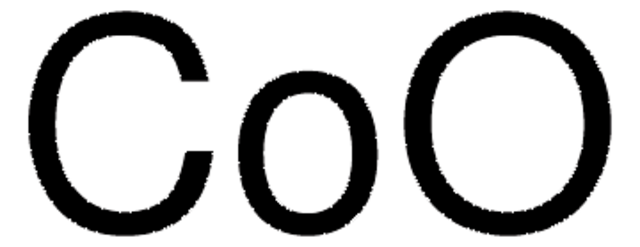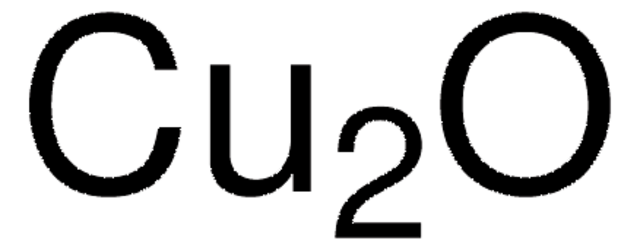637025
Cobalt(II,III) oxide
nanopowder, <50 nm particle size (SEM), 99.5% trace metals basis
Sinónimos:
Cobalt tetraoxide, Cobaltic-cobaltous oxide, Tricobalt tetraoxide
About This Item
Productos recomendados
Nivel de calidad
Ensayo
99.5% trace metals basis
Formulario
nanopowder
superficie
40-70 m2/g , typical range
tamaño de partícula
<50 nm (SEM)
mp
895 °C (dec.) (lit.)
densidad
6.11 g/mL at 25 °C (lit.)
densidad aparente
0.57 g/mL
aplicaciones
battery manufacturing
cadena SMILES
O=[Co].O=[Co]O[Co]=O
InChI
1S/3Co.4O
Clave InChI
LBFUKZWYPLNNJC-UHFFFAOYSA-N
¿Está buscando productos similares? Visita Guía de comparación de productos
Categorías relacionadas
Descripción general
Aplicación
- To modify the glassycarbon electrode for the detection of As(III) at nanomolar concentrationrange.
- To prepare a robust photocatalyst along withcarbon nanospheres for dye degradation and hydrogen evolution reaction.
- As an electrodematerial in the preparation of supercapacitors.
Palabra de señalización
Danger
Frases de peligro
Consejos de prudencia
Clasificaciones de peligro
Aquatic Chronic 3 - Carc. 1A Inhalation - Resp. Sens. 1
Código de clase de almacenamiento
6.1C - Combustible acute toxic Cat.3 / toxic compounds or compounds which causing chronic effects
Clase de riesgo para el agua (WGK)
WGK 1
Punto de inflamabilidad (°F)
Not applicable
Punto de inflamabilidad (°C)
Not applicable
Listados normativos
Los listados normativos se proporcionan para los productos químicos principalmente. Para los productos no químicos sólo se puede proporcionar información limitada. Si no hay ninguna entrada, significa que ninguno de los componentes está en la lista. Es obligación del usuario garantizar el uso seguro y legal del producto.
EU REACH Annex XVII (Restriction List)
Elija entre una de las versiones más recientes:
¿Ya tiene este producto?
Encuentre la documentación para los productos que ha comprado recientemente en la Biblioteca de documentos.
Los clientes también vieron
Artículos
Currently, magnetic nanoparticles (MNPs) are attracting a lot of attention because of the possibility of many novel applications, especially in biomedical research.
Graphene is a unique two-dimensional (2D) structure of monolayer carbon atoms packed into a dense honeycomb crystal that has attracted great interest due to its diverse and fascinating properties.
The application of magnetism and magnetic materials pervades our modern civilization in the form of electrical power, communications and information storage.
Magnetic materials permeate numerous daily activities in our lives. They are essential components of a diversity of products including hard drives that reliably store information on our computers, decorative magnets that keep the shopping list attached to the refrigerator door, electric bicycles that speed our commute to work, as well as wind turbines for conversion of wind energy to electrical power.
Nuestro equipo de científicos tiene experiencia en todas las áreas de investigación: Ciencias de la vida, Ciencia de los materiales, Síntesis química, Cromatografía, Analítica y muchas otras.
Póngase en contacto con el Servicio técnico











